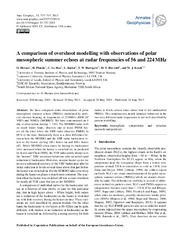A comparison of overshoot modelling with observations of polar mesospheric summer echoes at radar frequencies of 56 and 224 MHz
Permanent link
https://hdl.handle.net/10037/8718Date
2015Type
Journal articleTidsskriftartikkel
Peer reviewed
Author
Havnes, Ove; Pinedo Nava, Henry; La Hoz, Cesar; Senior, Andrew; Hartquist, Thomas W.; Rietveld, Michael T; Kosch, Michael J.Abstract
We have compared radar observations of polar mesospheric summer echoes (PMSEs) modulated by artificial electron heating, at frequencies of 224 MHz (EISCAT VHF) and 56 MHz (MORRO). We have concentrated on 1 day of observation, lasting ~ 3.8 h. The MORRO radar, with its much wider beam, observes one or more PMSE layers all the time while the VHF radar observes PMSEs in 69% of the time. Statistically there is a clear difference between how the MORRO and the VHF radar backscatter reacts to the heater cycling (48 s heater on and 168 s heater off). While MORRO often reacts by having its backscatter level increased when the heater is switched on, as predicted by Scales and Chen (2008), the VHF radar nearly always sees the "normal" VHF overshoot behaviour with an initial rapid reduction of backscatter. However, in some heater cycles we do see a substantial recovery of the VHF backscatter after its initial reduction to levels several times above that just before the heater was switched on. For the MORRO radar a recovery during the heater-on phase is much more common. The reaction when the heater was switched off was a clear overshoot for nearly all VHF cases but less so for MORRO. A comparison of individual curves for the backscatter values as a function of time shows, at least for this particular day, that in high layers above ~ 85 km height, both radars see a reduction of the backscatter as the heater is switched on, with little recovery during the heater-on time. These variations are well described by present models. On the other hand, the backscatter in low layers at 81–82 km can be quite different, with modest or no reduction in backscatter as the heater is switched on, followed by a strong recovery for both radars to levels several times above that of the undisturbed PMSEs. This simultaneous, nearly identical behaviour at the two very different radar frequencies is not well described by present modelling.
Description
Published version. Source at http://doi.org/10.5194/angeo-33-737-2015.


 English
English norsk
norsk